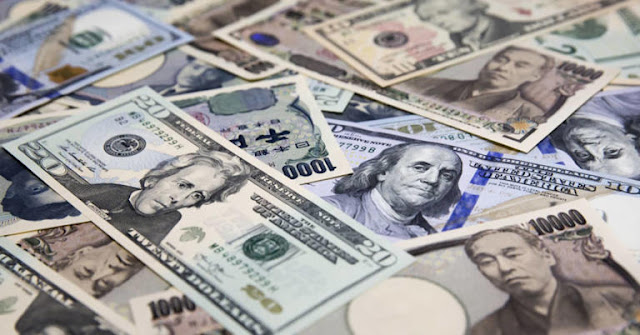The yen breached the 145 level against the dollar, raising expectations of BOJ intervention
The yen has continued to weaken after the Bank of Japan adjusted its stance on its yield curve control policy on July 28, sending 10-year Japanese government bonds to a nine-year high.The US dollar itself has also been in an uptrend since late July, with the dollar index climbing from a low of 99.77 on July 13 to the current level of 102.99.
HSBC believes Japan's Treasury will "start to push back in the 145-148 range." The Japanese government and the BOJ intervened to buy as low as 145 to the dollar in September 2022. The Japanese yen broke the 145 mark against the dollar on Monday for the first time since November 2022.On Friday, the Japanese currency briefly touched the same key psychological level.
The yen has weakened steadily since the Bank of Japan adjusted its stance on its yield curve control policy in late July, sending 10-year Japanese government bonds to a nine-year high. On Monday, HSBC said it expected Japan's finance ministry to "start pushing back in the 145-148 range." The Japanese government and the BOJ stepped in to buy the yen at 145 to the dollar in September 2022.
However, if the BOJ and the Japanese government do not intervene, HSBC says short yen positions are "likely to be restructured further". The note highlighted that these positions were reduced by more than 30% in July in the run-up to the BOJ's July 28 monetary policy meeting. The US dollar has also been in an uptrend since late July, with the dollar index climbing from a low of 99.77 on July 13 to the current level of 102.99.
HSBC said there is a “new factor” supporting the US dollar – namely high long-term US yields on concerns about the US budget deficit and Treasury stocks.” While this may be temporary, it is happening while our existing USD framework .. .not giving strong signals for a downtrend in the USD,” the bank said.
On Tuesday, Japan will report gross domestic product numbers for the quarter that ended in June. Inflation figures for July are due out on Friday. HSBC pointed out that "errors in data may also encourage bears".GDP is expected to rise 0.8% quarter-on-quarter, and the core consumer price index - which strips out fresh food prices - is forecast to reach 3.1%, according to a Reuters poll.
In a surprise turn of events, the Japanese yen (JPY) broke through the crucial 145 level against the US dollar (USD), sending shockwaves through financial markets. This rapid appreciation has fueled widespread speculation about the possibility of intervention by the Bank of Japan (BOJ) to stabilize currency markets. Let's dive into the factors leading to this surge, the potential implications, and what the financial world can expect in the coming days. It just crosses the 145 mark, the dollar, BOJ intervention, currency markets
The rise of the yen and the market response:
The recent rise of the Japanese yen above 145 against the US dollar is a development that has surprised many analysts. It is essential to understand the factors contributing to this sudden appreciation, as well as the initial market reaction.
One of the main factors behind the yen's rise is its safe-haven status. In times of uncertainty or global economic turmoil, investors often seek refuge in the yen, leading to increased demand. In addition, Japan's trade surplus and its position as a net creditor nation contribute to the yen's attractiveness.
Anticipation of BOJ intervention:
With the yen rapidly appreciating, market participants are now turning their attention to the Bank of Japan (BOJ). In the past, the central bank has intervened in currency markets to limit excessive volatility and maintain economic stability.
Expectations are growing that the BOJ may take action to stem the yen's rise and prevent it from damaging Japan's export-driven economy.Possible consequences:The yen's rise to 145 against the dollar has significant implications for various stakeholders, including businesses, investors and policymakers.
Exporters under pressure:
Japanese exporters, who benefit from a weaker yen as it makes their products more competitive in international markets, may face problems if it continues to strengthen. A stronger yen can erode their profit margins and affect overall export volumes.
Central Bank Dilemma:
BOJ finds itself in a delicate balancing act. While it aims to maintain stability in currency markets, it must also consider the possible consequences of intervention. A sudden and aggressive intervention could lead to criticism from trading partners and may even cause further market turbulence.
Global financial market impact:
The rise of the yen is also affecting global financial markets. Currency fluctuations can affect cross-border investments, trade deals and overall sentiment in the international financial community. Traders will be closely watching the BOJ's actions and statements in the coming days, which could influence market movements.
With the Japanese yen breaking above 145 against the US dollar, expectations of BOJ intervention add another layer of complexity to an already volatile currency market. Businesses, investors and politicians alike will be watching developments closely, as the outcome of these events could shape the short-term trajectory of both the yen and the wider global economy. Yen, dollar, BOJ intervention, currency market, Japanese Yen, USD/JPY, financial markets, exchange rates, Bank of Japan




0 Comments